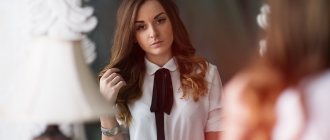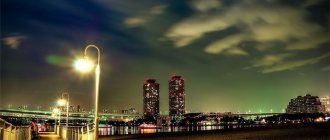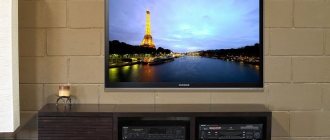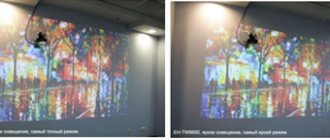Working in a studio is usually completely different from working on location, especially when it comes to shooting portraits. In location it is easy to focus on the model's face, but the surrounding environment also contributes. In addition, the studio has a lot of complex lighting equipment, and the photographer must create the light himself, and not adapt to the existing light.
Therefore, working in a studio often frightens novice photographers, leading them almost to a nervous breakdown. Here are 10 studio shooting tips that can really help you.
Where is the right, where is the left?
Photo By TheTruthAbout…
Clockwise orientation helps to some extent, but sometimes you still need to tell the model which way to go, and for this you need to know how to say it correctly. Among professional photographers, it is customary to indicate sides from the position of the model, since she does not have to think about where to go, but immediately follow the photographer’s command. It is very important to immediately agree with the model about this, especially if it is not a professional model.
Fixed focal length lenses
Photo By Widdowquinn
There are and always will be arguments for using zoom lenses in the studio, but if possible, use primes. They are usually sharper and brighter. A standard portrait lens has a focal length of approximately 80-200mm. If you are using a camera with a sensor smaller than a film frame (crop), do not forget about this when choosing a lens. For a full-frame Canon camera, photographers prefer 85mm f/1.2 and 135mm f/2 lenses, and for crop cameras, 50mm f/1.2 and 50mm f/1.4. Nikon photographers prefer the 85mm f/1.4
Be at the right height
Photo By Georgios Karamanis
Use the correct camera height for a variety of portraits, otherwise you risk getting the wrong perspective and distorted proportions. For a close-up portrait, hold the camera at the subject's eye level. If you're shooting a full-length portrait, hold the camera at chin level. For a half-length portrait, this will be the level of the chest, and for a full-length portrait, this will be the level of the abdomen. Although, for some creative shots you may need to lie down on the floor or use a stepladder.
Use a flash meter
Photo By Haribote
Modern cameras have a very developed exposure metering system. But she can't help you in the studio. You won't be able to determine how much power to light the background or hair, for example, until you take test shots. With the help of a flash meter, you can adjust the lighting scheme immediately and correctly. Just because you can read a histogram on a camera doesn't mean you shouldn't use a flash meter. This will save you from unnecessary headaches due to lighting.
How to set up a camera and light in a photo studio
You enter the studio, in the hall there is a forest of lighting fixtures that need to be installed and adjusted. In addition, there are also camera settings! Often beginners grab onto everything at once - this is their main mistake.
Camera settings. Switch to manual mode to independently control the three main parameters. Set ISO 100, shutter speed - 1/125, aperture - f/8. These are average universal settings for shooting a portrait of one person.
Leave them unchanged throughout the photo shoot, and adjust the amount of light in the frame only with the help of lighting fixtures. This way you will reduce to a minimum the number of parameters that need to be taken into account.
If you want to experiment, change the settings. The values we have proposed are not an axiom, but a starting point for a beginner. For example, if there is more than one person in the frame and you want everyone to be in focus, you can stop the aperture down to f/16.
Light settings. To simplify the task, place the source at a fixed distance from the model and do not move it any further. To find the right exposure for a photo, set the power to medium and take a test shot. Now you can see what to do next - increase or decrease power. Move it in increments of 0.5 power points until you get the desired result.
This will eliminate the need to rush around the room with the stand, while at the same time changing settings at random. If you still decide to move the light closer or further, move it and start adjusting from the beginning.
Photo: Elizaveta Chechevitsa / instagram.com/chechevic_a
Do not set the light source to maximum power - sometimes the photo studio specifies this point in the hall rental agreement, and if the employees see that you have violated the rule, you will have to pay the penalty specified in the contract. This is how the studio is trying to protect its equipment, which if broken, you will have to pay for, and to prevent traffic jams.
- Setting up multiple light sources. If the model is supposed to illuminate several devices, configure them one by one, without turning them all on at once. Place at the required distance, turn on the first source, adjust the power as in the previous paragraph. When the light is as desired, add a second fixture and so on. This way you will know exactly how a specific light source affects the picture and where the overexposure came from.
If you are shooting against a plain background, then mark the place where the model should stand with tape, and ask her not to move from this point. This way you don’t have to follow it around the hall, rearranging and adjusting sources. It is much easier to ask a person to turn around than to change the lighting scheme for each frame.
Custom White Balance
Photo By Dave Dugdale
We constantly require you to use custom white balance, and for good reason! Light modifiers such as umbrellas, softboxes, dishes, and snoots have a small effect on the color temperature and coloration of the light. Therefore, setting a custom white balance before shooting will ensure the most accurate color reproduction.
Secrets of working with a studio background
We tell you how to work with plain backgrounds - black, white and gray. They are universal, available in almost any studio in the form of paper rolls or cycloramas ( cyclorama is a design for photography without right angles, which allows you to get a plain background without shadows
). In addition, renting a room with a monochromatic background is cheaper than an interior one; there is nothing to distract from setting the light and working with the model - ideal for training a beginner.
How to get a white background in the studio
The main mistakes are placing the model too close to the background or sparing light sources. Often, a novice photographer simply turns the settings on one device to maximum, hoping that this way the light will reach the background and whiten it. This is partly true, but there is a high risk of overexposing the model and getting unnecessary shadows.
- Adjust the light on the model and place her away from the background.
- Add two more light sources to the lighting scheme, placing them on either side of the model and pointing them towards the background. This way it will receive an even and sufficient amount of light from both sides.
Make sure that sources are not included in the frame, or be prepared to remove them in post-processing with a stamp or using cropping / Illustration by the author
How to get a black background when shooting in a studio
- Place the model as far away from the background as possible so that the light does not reach or reflect from the wall or paper.
- Place the light closer to the model. Naturally, you will have to reduce the power of the source.
- Cover the light source from the background with a black flag (black screen on legs). If he is not in the hall, ask the staff.
If possible, curtain all windows and turn off unnecessary lamps. This is a must if you work with continuous rather than pulsed light / Illustration by the author
It is better to warn in advance when booking what you will need for the shoot, as sometimes there is less equipment in the photo studio than there are rooms.
- Close the aperture further.
- If possible and you are not afraid of hard light, take a nozzle that produces a narrow beam of light - this will reduce the likelihood that the background will be illuminated. For example, a tube, honeycomb, and beauty dish are suitable.
How to change the color of black and white backgrounds
If you need a background of a certain color, you don’t have to go through all the halls of the city in search of that very shade of soft pink or green. Make it yourself!
To get a delicate light color of low saturation, for example, blue or pink, you will need a white background, as well as blue or red filters. The most saturated and rich colors are provided by black or gray backgrounds.
The same red filter on black and white backgrounds / Photo: Elizaveta Chechevitsa / instagram.com/chechevic_a
Ask the studio staff for an additional light source with a reflector and attach a filter of the desired color to it. You don’t need to take anything with you - the studios always have sets of filters with different shades, as well as tape to attach them. In some studios, photo filters are built into square iron plates that fit into the reflector.
Point the source with a color filter at the background so that the light does not fall on the model. Help yourself with the curtains that are on the reflectors - close them so as to block the light from the model.
Try just one light source.
Photo By Bredgur
Famed fashion photographer Helmut Newton was known for using only one light. This, along with changing the angle of the lighting, can create truly dramatic and stunning photographs. If you have many light sources, this does not mean. that they all need to be used. Try a simpler approach to lighting, working with one source instead of several.
Studio portraits are quite difficult to perform. We hope these 10 tips will help you and inspire you to take more beautiful photos and continue to improve.
Posted by Mike Panic
Working with light for beginners in a photography studio
How to light a model evenly
There are two methods, not counting post-processing in graphic editors, that will help illuminate the model completely in a full-length portrait.
- Illuminate the model with stripboxes (a stripbox is an elongated attachment for studio light, a type of softbox), placing them on both sides of the model. To achieve uniform lighting, you will need three sources - two on the sides and one to illuminate the model as a whole.
- If, by design or due to circumstances, there is only one light source, put a softbox on it and raise it so that it is slightly higher than the model. Point the light as far down as the stand will allow so that it actually shines onto the floor.
Be prepared to spend time finding the ideal angle of the light source / Illustration by the author
It would be a mistake to lower the stand with the light down so that it shines into the belt, although logically it seems that this way the light will reach both the face and the legs. But no. Most likely, you will only get ugly shadows and upward lighting of the face, like in horror films when the hero shines a flashlight on his chin.
The second mistake is to place two light sources on top of each other, so that one illuminates the legs and the other the torso and head. There is a high probability of getting strange shadows and ruining the picture.
How to make hard or soft light
Soft light is smooth, as if shaded, and fairly light shadows, without clearly defined highlights. With hard light, the opposite is true - the shadow itself is deep black with a clearly visible outline, and the highlights are bright.
- To get soft light, place the source as close to the model as possible. Suitable attachments include umbrellas and softboxes.
- Hard light is produced if no attachments are placed on the sources. You can also use a type of attachment called a honeycomb, tube, or reflector - they provide a sharp, directional light. Softboxes and small octoboxes are also suitable.
Remember an important rule - the further the light is from the model, the harder it is, and vice versa.
You can delve deeper into the topic of what kind of light, accessories and attachments there are, and understand the types of umbrellas and softboxes, as well as their structure, in our material.
How to get beautiful eyeshadow
Often, for beginners, shadows spread over half the face, greatly darken the eyes, or grow as a “beak” on the side of the nose or under it.
The aesthetics and quality of shadows is affected by the location of the light relative to the model. For example, if you place the source in front, behind the photographer, the light will turn out flat, and the model’s face will lack volume. The same effect is achieved by the built-in flash or a removable flash on the camera, aimed “head-on”.
It is better to place the light to your left or right. Then a black and white pattern will appear on the model, which will make the picture three-dimensional, lively and interesting.
After that, experiment - raise the source higher to better illuminate the face and make the shadows look more natural. This option is more familiar to the eye, because we are used to seeing an object illuminated by the sun from top to bottom.
If you place a light source behind the model, in the photo you will only get a silhouette, an outline.










